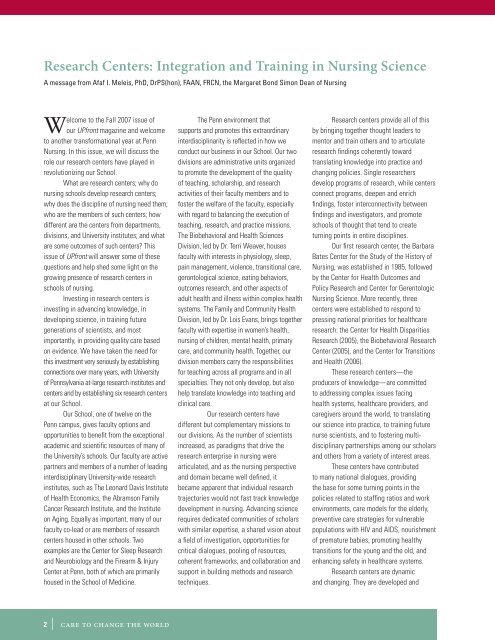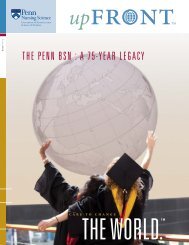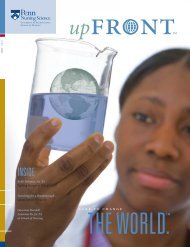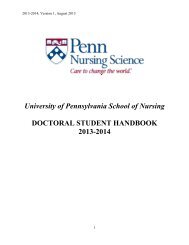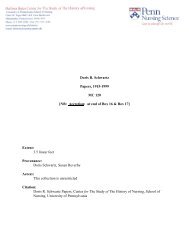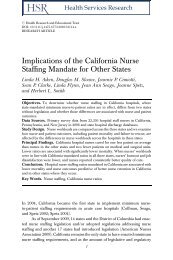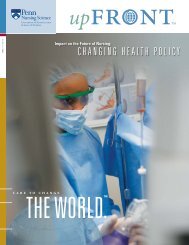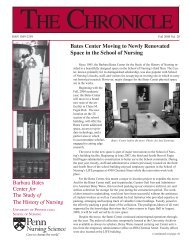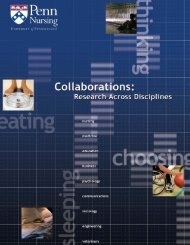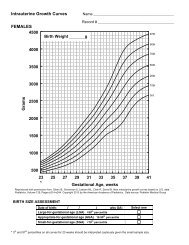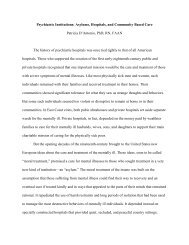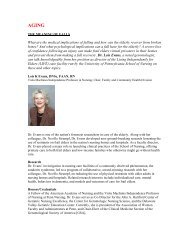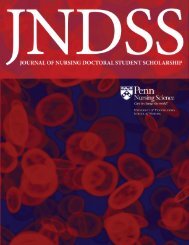Research Centers - University of Pennsylvania School of Nursing
Research Centers - University of Pennsylvania School of Nursing
Research Centers - University of Pennsylvania School of Nursing
Create successful ePaper yourself
Turn your PDF publications into a flip-book with our unique Google optimized e-Paper software.
<strong>Research</strong> <strong>Centers</strong>: Integration and Training in <strong>Nursing</strong> Science<br />
A message from Afaf I. Meleis, PhD, DrPS(hon), FAAN, FRCN, the Margaret Bond Simon Dean <strong>of</strong> <strong>Nursing</strong><br />
Welcome to the Fall 2007 issue <strong>of</strong><br />
our UPfront magazine and welcome<br />
to another transformational year at Penn<br />
<strong>Nursing</strong>. In this issue, we will discuss the<br />
role our research centers have played in<br />
revolutionizing our <strong>School</strong>.<br />
What are research centers; why do<br />
nursing schools develop research centers;<br />
why does the discipline <strong>of</strong> nursing need them;<br />
who are the members <strong>of</strong> such centers; how<br />
different are the centers from departments,<br />
divisions, and <strong>University</strong> institutes; and what<br />
are some outcomes <strong>of</strong> such centers? This<br />
issue <strong>of</strong> UPfront will answer some <strong>of</strong> these<br />
questions and help shed some light on the<br />
growing presence <strong>of</strong> research centers in<br />
schools <strong>of</strong> nursing.<br />
Investing in research centers is<br />
investing in advancing knowledge, in<br />
developing science, in training future<br />
generations <strong>of</strong> scientists, and most<br />
importantly, in providing quality care based<br />
on evidence. We have taken the need for<br />
this investment very seriously by establishing<br />
connections over many years, with <strong>University</strong><br />
<strong>of</strong> <strong>Pennsylvania</strong> at-large research institutes and<br />
centers and by establishing six research centers<br />
at our <strong>School</strong>.<br />
Our <strong>School</strong>, one <strong>of</strong> twelve on the<br />
Penn campus, gives faculty options and<br />
opportunities to benefit from the exceptional<br />
academic and scientific resources <strong>of</strong> many <strong>of</strong><br />
the <strong>University</strong>’s schools. Our faculty are active<br />
partners and members <strong>of</strong> a number <strong>of</strong> leading<br />
interdisciplinary <strong>University</strong>-wide research<br />
institutes, such as The Leonard Davis Institute<br />
<strong>of</strong> Health Economics, the Abramson Family<br />
Cancer <strong>Research</strong> Institute, and the Institute<br />
on Aging. Equally as important, many <strong>of</strong> our<br />
faculty co-lead or are members <strong>of</strong> research<br />
centers housed in other schools. Two<br />
examples are the Center for Sleep <strong>Research</strong><br />
and Neurobiology and the Firearm & Injury<br />
Center at Penn, both <strong>of</strong> which are primarily<br />
housed in the <strong>School</strong> <strong>of</strong> Medicine.<br />
The Penn environment that<br />
supports and promotes this extraordinary<br />
interdisciplinarity is reflected in how we<br />
conduct our business in our <strong>School</strong>. Our two<br />
divisions are administrative units organized<br />
to promote the development <strong>of</strong> the quality<br />
<strong>of</strong> teaching, scholarship, and research<br />
activities <strong>of</strong> their faculty members and to<br />
foster the welfare <strong>of</strong> the faculty, especially<br />
with regard to balancing the execution <strong>of</strong><br />
teaching, research, and practice missions.<br />
The Biobehavioral and Health Sciences<br />
Division, led by Dr. Terri Weaver, houses<br />
faculty with interests in physiology, sleep,<br />
pain management, violence, transitional care,<br />
gerontological science, eating behaviors,<br />
outcomes research, and other aspects <strong>of</strong><br />
adult health and illness within complex health<br />
systems. The Family and Community Health<br />
Division, led by Dr. Lois Evans, brings together<br />
faculty with expertise in women’s health,<br />
nursing <strong>of</strong> children, mental health, primary<br />
care, and community health. Together, our<br />
division members carry the responsibilities<br />
for teaching across all programs and in all<br />
specialties. They not only develop, but also<br />
help translate knowledge into teaching and<br />
clinical care.<br />
Our research centers have<br />
different but complementary missions to<br />
our divisions. As the number <strong>of</strong> scientists<br />
increased, as paradigms that drive the<br />
research enterprise in nursing were<br />
articulated, and as the nursing perspective<br />
and domain became well defined, it<br />
became apparent that individual research<br />
trajectories would not fast track knowledge<br />
development in nursing. Advancing science<br />
requires dedicated communities <strong>of</strong> scholars<br />
with similar expertise, a shared vision about<br />
a field <strong>of</strong> investigation, opportunities for<br />
critical dialogues, pooling <strong>of</strong> resources,<br />
coherent frameworks, and collaboration and<br />
support in building methods and research<br />
techniques.<br />
<strong>Research</strong> centers provide all <strong>of</strong> this<br />
by bringing together thought leaders to<br />
mentor and train others and to articulate<br />
research findings coherently toward<br />
translating knowledge into practice and<br />
changing policies. Single researchers<br />
develop programs <strong>of</strong> research, while centers<br />
connect programs, deepen and enrich<br />
findings, foster interconnectivity between<br />
findings and investigators, and promote<br />
schools <strong>of</strong> thought that tend to create<br />
turning points in entire disciplines.<br />
Our first research center, the Barbara<br />
Bates Center for the Study <strong>of</strong> the History <strong>of</strong><br />
<strong>Nursing</strong>, was established in 1985, followed<br />
by the Center for Health Outcomes and<br />
Policy <strong>Research</strong> and Center for Gerentologic<br />
<strong>Nursing</strong> Science. More recently, three<br />
centers were established to respond to<br />
pressing national priorities for healthcare<br />
research: the Center for Health Disparities<br />
<strong>Research</strong> (2005), the Biobehavioral <strong>Research</strong><br />
Center (2005), and the Center for Transitions<br />
and Health (2006).<br />
These research centers—the<br />
producers <strong>of</strong> knowledge—are committed<br />
to addressing complex issues facing<br />
health systems, healthcare providers, and<br />
caregivers around the world, to translating<br />
our science into practice, to training future<br />
nurse scientists, and to fostering multidisciplinary<br />
partnerships among our scholars<br />
and others from a variety <strong>of</strong> interest areas.<br />
These centers have contributed<br />
to many national dialogues, providing<br />
the base for some turning points in the<br />
policies related to staffing ratios and work<br />
environments, care models for the elderly,<br />
preventive care strategies for vulnerable<br />
populations with HIV and AIDS, nourishment<br />
<strong>of</strong> premature babies, promoting healthy<br />
transitions for the young and the old, and<br />
enhancing safety in healthcare systems.<br />
<strong>Research</strong> centers are dynamic<br />
and changing. They are developed and<br />
2 | care to change the world


